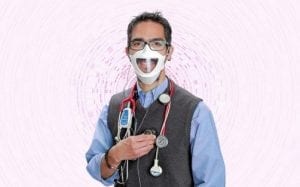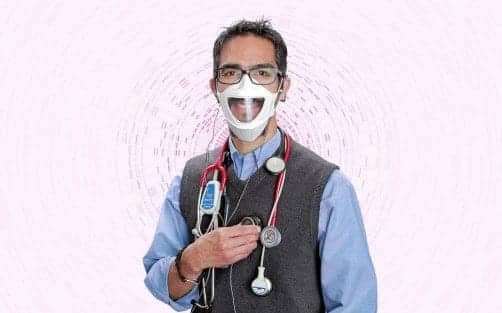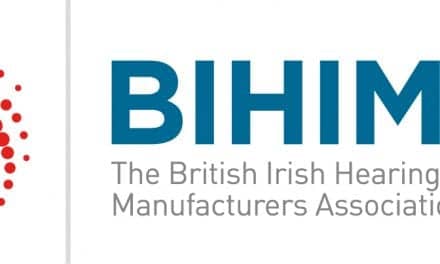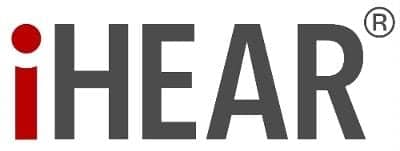A University of Arkansas at Little Rock faculty member is hoping to make visits to healthcare professionals easier for patients and other health workers who are deaf or hard of hearing, the school announced on its website.
Dr Samuel Atcherson, a faculty member at the University of Arkansas at Little Rock Department of Audiology and Speech Pathology, is researching a prototype transparent surgical face mask that allows those who are deaf or hard of hearing and non-native English speakers, to read lips.
The face mask will make it easier for people who have trouble understanding orally, but Atcherson said the mask was originally designed with a completely different purpose in mind.

Dr Sam Atcherson wears medical equipment, a transparent face mask, and amplified stethoscope he is researching. They are designed to help deaf and hard-of-hearing patients and doctors better communicate.
“These transparent masks weren’t initially conceived to help deaf and hard-of-hearing people,” Atcherson said. “Wearing a mask can be intimidating to others. It was thought it would be easier for children if they could see more of the doctor’s face, but the transparent face masks allows people to read lips. This is especially important in noisy settings where people are having a hard time hearing. This could even improve communication access for a person with normal hearing who is in a noisy setting or who is speaking to a person with a foreign accent. We try to think about it universally rather than just for people with hearing loss.”
Atcherson is a co-investigator with the mask’s inventor, Jeanne Hahne, a nurse in San Francisco. They received a two-year, $95,602 grant from the National Institutes of Health (NIH) in July 2016 to develop and test the transparent mask. Atcherson is conducting two research studies to determine how well the mask works and how people feel about the use of the mask.
“The first study is a speech perception-in-noise study,” he said. “We have three groups of participants: people with normal hearing, those with moderate hearing loss, and people who have severe to profound hearing loss. To prepare for this study, we obtained audiovisual recordings of a male and a female speaker wearing no mask, the traditional mask, and the transparent mask repeating sentences displayed on a screen. The participants in the study were recruited to listen to and watch the speakers and repeat the sentences presented. We are comparing how well people can understand what people are saying while wearing the traditional mask and the transparent mask or no mask at all.”
Typically, wearing the traditional mask versus the transparent mask makes no difference in how well people with normal hearing understand the speakers.
“People with nominal hearing loss usually have a slight benefit with being able to see the lips of the speaker,” Atcherson said. “For the group of people with severe to profound hearing loss, that made the biggest difference. Being able to see someone’s lips move can provide greater access and understanding, even if you can’t read lips. For the two groups with hearing loss, being able to see lips moving reduces the fatigue factor. You use less energy trying to understand what someone is saying.”
Atcherson said much of his research has spanned from his involvement with the Association of Medical Professionals with Hearing Loss (AMPHL).
“I’ve been involved with this group for 18 years. What I noticed very quickly is that there was a lot of misinformation about hearing aids and hearing implants,” he said. “Lots of people had lots of questions on how to use a stethoscope with these devices. I imagine the general public isn’t aware there are amplified stethoscopes on the market. Your hearing aid and hearing implant is designed to provide access to speech frequencies, but heart sounds have energy much lower in frequency. Sometimes, an implant or hearing aid can’t deliver the sounds, so we try to come up with alternative strategies to address these issues.”
In his spare time, he and other fellow researchers have been working to understand the benefits and limitations of various amplified stethoscopes to help healthcare professionals and students with hearing loss detect heartbeats and lung sounds. The goal of their research is to find a way to successfully integrate hearing implants, hearing aids, and amplified stethoscopes to help healthcare professionals and students who are deaf or hard of hearing practice medicine.
“It’s really a compatibility issue. You have these three devices, and everyone’s hearing loss is different. Everyone has different hearing aids and hearing implants,” Atcherson said. “It’s important to integrate these three technologies so that healthcare professionals with hearing loss can continue to do their jobs, and so healthcare students can pass their technical standards. Eventually, I feel like there is enough shared knowledge in the association that we can figure out how to connect these devices.”
Source: University of Arkansas at Little Rock
Photo: Ben Krain, UA Little Rock Communications






Interesting to see this article almost a year prior to COVID-19. I’ve been making cloth masks for people, including transparent lip reading masks to be used for speech therapy, hard-of-hearing or other hearing challenged people. Least I can do during these trying times. Hang in there everyone!
Please I am a nursing supervisor that works with medically fragile children. I am hard of hearing as are many of my kiddos. I have about 15 staff and 38 children. How can we get some of these masks.
What a wonderful idea!! I hope Dr Samuel Atcherson can mass produce the masks very soon. I am hard of hearing and I have been reading lips all my life. This great idea will help not only the hard of hearings but also all people to communicate better and to see the wonderful mouth and lips of the person.